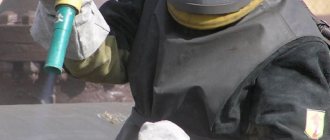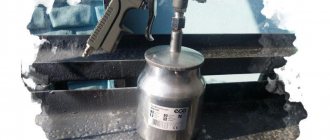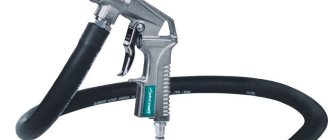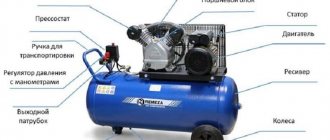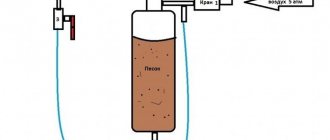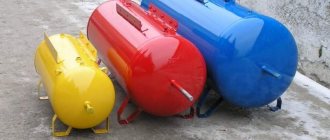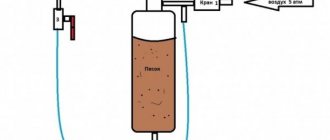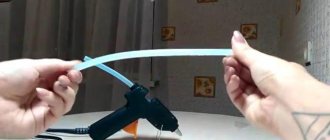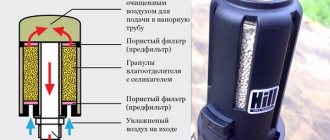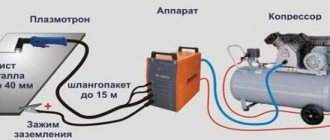- Lever.
- Trigger.
- Nozzle for spraying air-sand mixture.
- Bushing for connecting a tank or sand supply hose.
- Sand reservoir.
- Bushing for connecting the air supply hose from the compressor.
In many ways, a sandblasting gun resembles a spray gun, only the nozzle here is made of a different material and has a different diameter. The principle of its operation is as follows: compressed air from the compressor is supplied through the hose through the bushing ( 6 ). At this time, abrasive is sucked out of the reservoir ( 5 ), which is supplied to the nozzle ( 3 ) of the gun. And the abrasive is blown out of the nozzle under pressure onto the material being processed. Essentially, the gun has an injection method of operation, in which air and sand are supplied through different hoses. Because of this, the performance of conventional pistols is several times less than that of sandblasting machines, and they are much weaker than their larger-sized counterparts.
Sand supply method
The abrasive can be collected directly from the attached tank or from another tank using a hose. What is the best sandblasting gun, hose-fed or barrel-fed? It all depends on the amount of work being done. For example, if you need to clean 1 - 2 m2 of sheet metal, then a regular tank will be enough. But it needs to be constantly replenished, which means downtime. The advantage is its mobility, that is, you will have to drag fewer hoses. We can say that a pistol with a barrel is intended for small-scale work in the garage.
For larger jobs, it is better to choose a hose sand supply. In this case, the hose is lowered into a sand reservoir, such as a large barrel, and the sand is fed until it runs out. This method of supplying abrasive is convenient when you need to clean a large area, for example, a car body. However, due to the hose, some of the mobility that a device with a tank has is lost. In general, this is not critical if the sandblasting machine is in our garage and we perform all the work in one place. Also, hose sandblasters have a higher air consumption and require higher pressure. If for devices with a tank approximately 3 - 4 bar is enough, then for hose devices you need 5 - 8 bar.
Peculiarities
This small device is designed for surface preparation using the abrasive method. The directed flow of sand jet allows you to get rid of dirt, change the structure of the coating and engrave all kinds of designs. In addition, this technology, being highly efficient, makes it possible to clean various surfaces even in hard-to-reach places. After appropriate treatment, the surface is ready for maximum adhesion to paint products.
The most relevant area of application of this method is cleaning a metal surface during auto repair. Using high jet pressure, old coating, rust, and scale are removed, resulting in a perfectly clean surface. Parts painted after this treatment last quite a long time. A similar technology can be used when working with concrete, wood and brick products.
Small devices differ from industrial ones in their design characteristics and the injection equipment used.
No such device will do its job better than a sandblasting model. After all, after the operation, no scratches remain, as in the case of using sandpaper, but at the same time the most inaccessible places are cleaned.
Material of manufacture and diameter of nozzles
When purchasing, it is important to pay attention to the material used to make the nozzles, as this is the main consumable material in the gun. As sand rubs against the inside of the nozzle, the material is gradually “eaten up.” Gradually, such a nozzle begins to wheeze and whistle like an ultrasonic plane, thereby indicating that it is time for it to retire. The best materials for nozzles remain ceramics and tungsten carbide. The easiest way to find ceramic nozzles on sale.
- Home Appliances
Pumping air in liters: the best oil compressors 2020
Also select the size of the nozzle, taking into account the pressure it needs to operate properly and the performance of the compressor. And if the compressor usually does not have problems with pressure (most are capable of freely delivering up to 8 bar), then you need to pay close attention to performance. Below is an approximate dependence of the nozzle outlet diameter on the compressor performance:
- 2 mm – 0.2 – 0.3 m3/min.
- 3 mm – 0.3 – 0.6 m3/min.
- 4 mm – 0.6 – 1.2 m3/min.
- 6 mm – 0.9 – 1.8 m3/min.
Based on the fact that in most cases we first buy a compressor, and only then choose a sandblasting gun, pay attention to the performance of your compressor to select the optimal nozzle diameter.
Mini sandblaster for a small compressor
Before starting any painting work, to achieve a high-quality result, it will be necessary to clean the surface from various types of contaminants. For such a case, a special mini-sandblaster is suitable, which can be used at home. In this article we will take a closer look at the characteristics of such a compact sandblaster for a small compressor.
Connection of nozzles and air hoses to the gun body
The important elements in a sandblasting gun are the connecting fasteners. The nozzles can be attached to the gun using a union nut or a grub screw. During operation, vibration can cause the nut to often loosen, which is why it will have to be constantly tightened. The threaded pin in this case is much more reliable and does not unscrew due to vibration.
The air supply hose can be connected to the gun body using a tightening coupling or a rapid-type quick-release coupling. If the coupling is not tightened properly, the pressure hose may break off. But this will not happen with a quick-release connection, so we recommend purchasing a device with this air hose design. For example, you can take a Matrix 57328 with a rapid mount.
Do-it-yourself sandblasting: how to assemble a useful tool from scrap materials
Before finishing the surface, it must be cleaned of dirt and old coating. Anyone who has ever prepared walls for painting or removed rust from metal can imagine how much effort and time this process takes. If you do this manually, the result is not always satisfactory. A sandblaster is a device that polishes a surface with sand. Making sandblasting with your own hands is not such a difficult task.
A sandblaster is a device that can be used to clean any surface with sand.
Rating of sandblasting guns 2022
Sturm AU-1720-03
Sandblasting gun made in China for working with sand and other abrasive materials. This device has an abrasive supply from a tank. The tank is made of stainless steel and has a volume of 1 liter. A pressure of 4 bar is sufficient for this gun. The kit includes connecting fasteners for the air supply hose of the bayonet type. This is a type of quick release fastener in which one part of the coupling is rotated and secured to another part of the coupling.
Air consumption is 164 l/min, but users note that a compressor with a capacity of at least 200 l/min is needed. The diameter of the air hose connection sleeve is ¼ inch. The kit comes with a fairly thin 2.5 mm nozzle. This gun is certainly not for large volumes of work, but it is quite suitable for household tasks.
Fubag SBG 142/3.5
This is a fairly popular sandblasting gun that has proven itself well in cleaning bodies of old paint and rust. A stainless steel tank with a capacity of 0.8 liters, as well as a nozzle with a diameter of 6 mm, are standardly installed here. Thanks to this nozzle, you can remove paint from a large area. However, the tank will be used up quite quickly, so be prepared to refill it with abrasive often.
The diameter of the air hose connection sleeve, like the previous model, is ¼ inch. The gun consumes about 142 l/min, and it requires a compressor with a tank capacity of at least 70 l and a capacity of at least 260 l/min. It operates with a pressure of 3.5 bar. The model is distinguished by high-quality assembly and reliable operation. The manufacturer provides a 2-year warranty on it.
Matrix 57326
This is a more powerful sandblasting gun, and it is intended for more serious work. Operates with a pressure of 4 bar, flows up to 230 l/min. To work with it, we recommend using a compressor with a capacity of at least 300 l/min.
The gun uses a 6mm diameter nozzle. The manufacturer recommends using abrasive material with a grain size of 1.6 mm or less to work with it. However, from experience we can say that the device copes quite well with sand with a grain size of up to 2 mm. The pistol is not as popular as the Fubag SBG 142/3.5, but is not inferior to it in terms of reliability and performance.
Metabo SSP 1000
The Metabo company produces not only high-quality power tools, but also good equipment for auto repair shops, of which the Metabo SSP 1000 professional sandblasting gun is clear proof. To operate it, you will need a compressor capable of delivering a pressure of 7 bar and an air flow of about 400 l/min. The gun itself consumes up to 300 l/min.
The manufacturer included 3 ¼-inch bushings (nipple) for connecting the air hose: EURO, ISO and ARO/Orion. The connection of the bushing to the gun body is made using quick-release rapid fasteners. This model has a good quality vacuum tank and nozzle. If you need a gun for regular and not one-time work, feel free to take this device from Metabo.
Another tool for the auto repair shop:
- Let's tighten everything: how to choose a reliable wrench?
- Ready for anything: 7 powerful cordless screwdrivers
Safety precautions
If safety precautions are not followed, sandblasting poses a serious health hazard. Basic rules that anyone working with this unit should know:
- Eyes and skin must be protected. All small particles fly out of the gun at great speed. If they come into contact with exposed skin or mucous membranes, they cause severe damage. Therefore, when working, be sure to wear special clothing and glasses, since getting abrasives in the eyes is the most dangerous.
- To prevent a powerful flow of dust from causing damage to the respiratory system, it is necessary to work with a sandblasting machine wearing a respiratory mask. A reliable ventilation system should be installed in the room if sandblasting work occurs there regularly.
- Be sure to use headphones as the compressor produces high noise levels that can cause injury to the ear canal if used regularly under such conditions.
Step-by-step assembly of sandblasting with your own hands
After all the parts necessary for manufacturing have been prepared, we proceed directly to assembly. First you need to completely empty the cylinder of gas. To do this, unscrew the valve and wait until the gas comes out completely. You need to be extremely careful, because if you ignore this stage, unpleasant consequences are possible. To be sure that the gas has completely left the cylinder, it is recommended to insert a hose previously connected to the compressor. Then the gas mixture is completely pumped out.
After the tank is completely empty, you need to make 2 holes in it: one at the bottom of the tank (1.2 cm in diameter), the second on the opposite side. It is in the second hole that a 2-inch tap will be installed. A pipe of the same diameter is also attached here. Then the following steps are performed:
The nozzle attached to the hose must be secured with a clamp.
- A DU-15 steel tee is welded to the bottom of the cylinder, where the sand will collect. Only high-quality welding will ensure the tightness of the connection.
- To ensure stability of the structure, a tripod should be welded or the wheels should be secured. The second option will greatly facilitate the transportation of the device from place to place.
- After completing the frame manufacturing work, they begin fastening small components. A fitting is placed on each thread, and all functional units are sealed with fum tape. It is important to ensure that all connections are tight.
- Threaded bushings are mounted on the open ends of the installed tee. One of the outlets of the pipe is closed with a 14 mm hose, and the second with a copper tube with a diameter of 10 mm. A reinforced sleeve is attached to the copper pipe.
- A 14 mm fitting is connected to the valve on the cylinder. Then you need to take a 14 mm hose and fix it (using a collet clamp) to the cylinder, the other edge is attached to the tee with a clamp.
- A sleeve is mounted on the remaining free end of the tee, connecting the tee mixer with the nozzle.
At the last stage, the compressor is connected to the mixer using a 10 mm hose, after which you can try to connect the installation and begin operation. If it is necessary to increase the sand supply power, an additional fitting is attached to the container, the other end of which is connected to the compressor.
Compressor unit design
When choosing a compressor, it is recommended to decide which engine will be used for the drive. Typically used:
- Electric motors, they operate on 220 or 380 V.
- Gasoline engines consume A-92 gasoline as fuel (usually four-stroke devices are installed, but some manufacturers also install two-stroke engines).
- Diesel power plants. Solar oil is used as fuel.
Types of drives for household and industrial compressors:
Compressor equipped with diesel engine. Power is 12 kW, equipped with a 350 l receiver:
Heat engines allow compressors to operate autonomously. Such installations are operated when performing work at a distance from power sources. They are used to work on remote construction sites:
- During the repair and construction of bridges and overpasses. There it is necessary to clean the reinforcement from various impurities before subsequent pouring with concrete.
- In case of destruction of objects taken out of service. The country is undergoing an extensive renovation of the housing stock. We have to demolish buildings that are unfit for habitation. They contain significant volumes of metal frames. To remove construction waste, you need to remove the reinforcement. Sandblasting units assist in cleaning.
- If it is necessary to use high-performance equipment, compressors based on diesel or gasoline engines can produce tens of cubic meters per minute.
A household compressor uses a single-cylinder device. The drive is carried out by a V-belt. It is these installations that have become widespread in small car repair shops:
- Electrical equipment with power supply up to 3.0...3.5 kW is usually operated from a 220 V network. They are connected with ordinary plugs. In this case, the current consumption does not exceed 15 A. Such installations are used in small industries or by individual entrepreneurs engaged in car repairs.
- If it is necessary to use more productive units, a 380 V network is used for power supply. It is capable of connecting compressors that consume up to 90...100 kW of electricity. Such installations can produce up to 5...10 m³/min. Such devices are installed in industrial enterprises.
- In factories or workshops, they try to locate power equipment in a separate room. Then the sound from operating devices will tire the ears of workers less. Compressed air is supplied from compressors through pipes.
- Modern enterprises widely use polypropylene pipes. They are easy to weld together, and it is not difficult to organize branching and distribution to different consumers.
- To evenly load the network with compressed air, receivers are installed near consumers. They smooth out pressure pulsations. The available reserve allows the operation of technological equipment in optimal modes.
- To operate sandblasting, they try to place a 500...800 liter receiver near the object. Then, during operation, a productivity reserve will be provided. The work will be carried out in a stable mode.
Video: compressor for sandblasting.
Application of technology
A sandblasting gun is a device for carrying out abrasive processing of various materials, surfaces, and objects. As an independent device or in conjunction with a sandblasting chamber, it is used in construction and repair, metallurgy, instrument making, the automotive industry, and a number of other industries.
The device is in demand for different types of work:
- removing rust before applying anti-corrosion compounds, other protective agents or to extend the service life of products;
- grinding wood, metal, plastic, stone, ceramics (objects, blanks, individual components) before decorating;
- cleaning from dirt and old paintwork;
- frosting glass to give an opaque effect (dishes, showers, windows);
- degreasing metal before coating with varnish or paint;
- applying drawings to glass and other materials;
- cleaning parts of complex shapes;
- restoration of art objects;
- imparting roughness to materials in order to enhance adhesion with various coatings;
- artificial aging of wood - furniture, decor, interior elements;
- cleaning the car body from dirt and old coatings before painting.
A sandblasting gun is indispensable for cleaning various curved parts: you can spend a lot of time on this process manually, and the quality of preparation of the product will not be the best. When using sandblasting, even hard-to-reach areas will become perfectly clean and sanded in a short period of time.
Types and types of abrasives for surface treatment
The main consumable for work is abrasive, under the influence of which the surface is cleaned. Sand simply taken from the river bank will not be suitable for this purpose, because it has a heterogeneous composition, and its particles are unequal in size and shape. All this will subsequently affect the quality of the treated surface. In addition, large grains of sand break down and turn into dust during the cleaning process, and the abrasive itself very quickly becomes unusable, so it needs to be constantly renewed.
First of all, you need to remember that only special types of abrasive are suitable for high-quality cleaning. Often this is not only sand, but also other suitable materials of artificial and natural origin. The choice of option will depend on the specifics of the work. The main parameters in this case are:
- hardness;
- size;
- form.
On a note! In most countries, it is prohibited to use ordinary quartz sand for sandblasting, because quartz particles upon impact with metal turn into dust, which can cause severe pulmonary diseases. In addition to affecting the health of the sandblaster, the dust can harm others, even those far from the work site.
Sandblasting machines use such types of sand as river, quarry and industrial quartz.
In general, the design of a sandblasting machine involves the use of such types of sand as:
- Regular river. The material must be sieved to obtain a homogeneous composition.
- Career. Somewhat finer than river material, but in addition to sifting, the material requires additional washing.
- Industrial quartz. A derivative of ordinary sand, obtained by sifting and dividing into fractions. The cost is 3 times more expensive than the river one.
- Special crushed abrasive. Obtained as a result of crushing quartz rocks. High efficiency in this case is ensured by the acute-angled shape of the grains, which has a good effect on the surface.
What parts are useful as components for making sandblasting with your own hands?
Before sandblasting, you should make sure you have the necessary parts, most of which can always be found in your garage, storage room or workshop. You should look for missing items at flea markets or hardware stores. One of the important components is the container from which abrasive sand will be supplied to the main line. Most craftsmen prefer to use an old gas cylinder for this purpose.
Note! If you use a gas cylinder for work, you should carefully check that there are no signs of rust, dents or other damage. In addition to using the cylinder as a container for abrasive, it can be useful for making a receiver for a compressor, however, during disassembly, maximum safety precautions must be observed.
Without all the necessary parts, it will not be possible to assemble a sandblasting machine.
In order for the container to be freely filled with abrasive, it is necessary to weld a piece of pipe to the container. For convenience, a neck should be fixed in the upper part, which will act as a funnel for pouring sand.
You will also need other equipment for sandblasting:
- Ball Valves. It is better to choose the most reliable and durable materials from trusted manufacturers with a good reputation.
- Reinforced rubber hose. The best option is a sleeve with a diameter of 14 mm, which is designed for high pressure and constant friction of abrasive sand.
- Gas hose. The diameter of the product must be at least 1 cm. It is through this hose that compressed air will be supplied to the system, which has not yet mixed with the abrasive material.
- Collet-type fittings and clamps. Needed to secure hoses to other elements of the system.
- Fum tape or other sealant. All connections require reliable sealing, because sandblasting works under constant high pressure.
Most of the parts you need can be found in your garage.
What to pay attention to
Before you start purchasing, it is recommended that you familiarize yourself with some factors that will make it easier to determine the performance of the device:
- The kit must contain hoses that connect to the container and the gun. It is important that they have thick walls, as this will allow them to withstand high loads and not break.
- It is important to pay attention to the size of the nozzle, since the feed rate of the working material depends on it.
- If the design contains plastic parts, you can forget about durability. Most experiments confirm that these are the models that break first.
- The handle must be made with high quality to make it more convenient to work.
